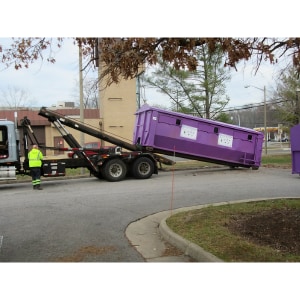
The focus of EarthCare is Education, Action and Service
EarthCare supports:
- environmental sustainability
- addressing ecology
- climate change
EarthCare is active in conservation through initiatives like:
- pollinator protection
- green infrastructure
- energy efficiency
- wildlife-friendly gardening
EarthCare maintains all of our sacred five acres. They host:
- Spring and Fall Beautification Days
- Summer Weed-Pulling and Pizza Parties
Please SIGN UP to be placed on our mailing notification list.
📅 Monthly on the first Tuesday
🕑 7 - 8:00 p.m.
📍 Room 1 (Conference Room)
📇 Contact us: Mary Brown (cernybrown@earthlink.net) or Casey Tarr (eileentarr1@verizon.net)
Upcoming Projects
More to share
- See our Summer Spruce Up photo album
- Walk our Labyrinth and experience nature in our Meditation Garden
- Visit the Medicine Wheel in the Meditation Garden
Recycle glass bottles and jars
 Are you taking advantage of the glass recycling purple bins in our area? Depending on where you live, it may take some effort to transport your collection to a bin site. But it’s one action that we know is worth the extra work.
Are you taking advantage of the glass recycling purple bins in our area? Depending on where you live, it may take some effort to transport your collection to a bin site. But it’s one action that we know is worth the extra work.
We are fortunate that in our region, we can be certain that our glass become a resource. It may go straight into making new bottles or used in construction.
- Glass bottles and jars can be recycled endlessly without losing purity or quality
- The amount of energy required to melt glass down is low
- According to the Glass Packaging Institute, recycled glass can be substituted for up to 95% of raw materials
- According to Treehugger.com, if a glass bottle does not get recycled, it is estimated that it will take 1 million years to decompose naturally.”
For more information on what happens to glass in the purple bins, read Giving Glass Bottles and Jars a New Life in the Connection Newspapers.
As Fairfax County Board of Supervisors Chair Jeff McKay explains,
“There are remarkable environmental benefits including reducing the volume in our landfills and lowering carbon dioxide and other greenhouse gases . . .There are also economic benefits as the County has to purchase fewer construction materials when it uses recycled glass. Glass-to-glass recycling even supports hundreds of jobs in the state.”
Fairfax County - Public Works and Environmental Services website: Purple Bin locations
Turn Water Off When Brushing Teeth
It doesn’t sound like a significant act, but when you take into account the energy used to clean and pump water that simply runs, unused, down the drain just to be treated and pumped again, it adds up. According to Treehugger.com:
“The average faucet releases two gallons of water per minute. If you brush twice a day for the recommended two minutes, you can save up to eight gallons of water every day by turning off the tap while you brush.”
Add a New Native Plant to Your Yard
 Native plants are a way to address habit loss with beauty. A simple act of adding a plant that provides food or shelter to insects has an impact on the whole ecosystem.
Native plants are a way to address habit loss with beauty. A simple act of adding a plant that provides food or shelter to insects has an impact on the whole ecosystem.
From Treehugger.com:
“By planting nectar-rich species of plant in our gardens and trying to include nectar-rich plants to provide for as many different pollinator species as possible, we can increase the number of beneficial interactions in the ecosystems around us and boost biodiversity.”
“And when we increase the number of beneficial interactions within a system, we increase the resilience and stability of the system as a whole.”
“By making sure that we have nectar-rich plant species present throughout the year, we can aid many pollinator populations that are threatened by human activity and climate change, and help to halt biodiversity losses.”
Why Choosing Nectar-Rich Plants for a Garden Is So Important at Treehugger.com
For more information on choosing native plants and where to buy them, check Plant NOVA Natives
Environmental Practices on the Grounds
The Retention Pond, the Riparian Buffer and Bluebird Boxes
Installations on the Grounds
The Green Roof, the Labyrinth and the Stone Wall Garden
Visit our Labyrinth page.
Outreach to Church Members and the Community
EarthCare and our Youth, Member and Community Practices and the EarthCare Team
EarthCare Background
- Ongoing actions sponsored by EarthCare are listed on the EarthCare Actions page on our website.
- The legacy of EarthCare at Unity of Fairfax is on the EarthCare Legacy page on our website.
- Twenty-nine important files from the history of EarthCare are stored in the EarthCare Archive.

